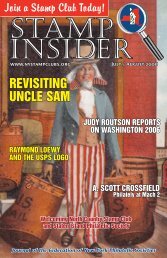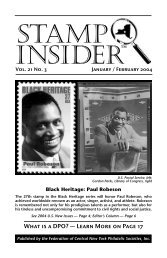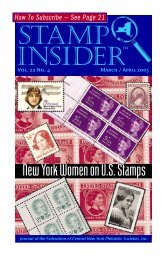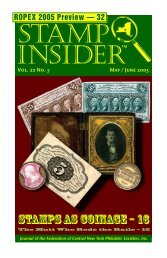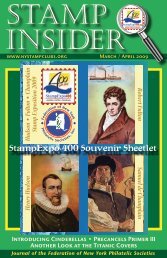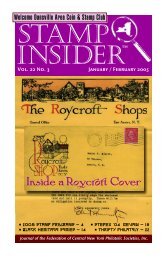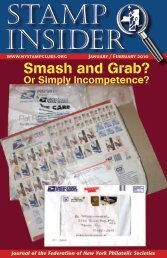Shows for - Stamp Insider Online
Shows for - Stamp Insider Online
Shows for - Stamp Insider Online
Create successful ePaper yourself
Turn your PDF publications into a flip-book with our unique Google optimized e-Paper software.
The Story Behind the <strong>Stamp</strong> by Daniel A. Piazza<br />
U.S. 2005 Lunar New Year Double Sided Pane of 24<br />
In 1988, the Organization of Chinese Americans<br />
began lobbying the USPS to promote<br />
their cultural heritage. Clarence Lee was<br />
commissioned to design the 1992 Chinese<br />
New Year stamp (Scott 2720). His cut-paper<br />
rooster and Chinese calligraphy on a red<br />
background was popular not only here, but<br />
also in China where 2 million were reportedly<br />
sold. The USPS decided to continue the series,<br />
and Lee created a stamp featuring a different<br />
animal of the Chinese zodiac <strong>for</strong> the next 11<br />
years, culminating with the 37-cent Year of<br />
the Monkey (Scott 3832) in 2004. USPS planned to end the series in 2005 with a miniature<br />
sheet of all 12 stamps redenominated with the first-class rate, 37 cents.<br />
Intending it as an honor <strong>for</strong> Lee, the USPS was surprised when some Chinese were horrified.<br />
The problem: 12 × 37 cents = $4.44, and many Chinese have an almost pathological<br />
fear of the number four, unlucky because when spoken in Cantonese it sounds like the word<br />
<strong>for</strong> death. The fear is apparently deadly <strong>for</strong> some: a study in the December 22, 2001 issue of<br />
the British Medical Journal suggested that Chinese patients were 13 percent more likely to<br />
die of a heart attack on the fourth of the month. When the number must be written, it is<br />
often enclosed in a circle to isolate its harmful powers. Tetraphobia is widespread in Asia.<br />
Japan’s All Nippon Airways has no seats or rows numbered four on any of its aircraft. USPS<br />
redesigned the sheet as a double-sided pane of 24 (Scott 3895) — the first issue of its kind;<br />
all previous double-sided panes were sold in booklet <strong>for</strong>m only. The new face value, $8.88,<br />
was much more acceptable; the Chinese word <strong>for</strong> eight sounds similar to that <strong>for</strong> prosperity,<br />
so it is considered lucky.<br />
The panes were released<br />
January 6, 2005 in Honolulu.<br />
The set was reissued this year<br />
as a sheet of 12 reflecting the<br />
new 39-cent rate.<br />
Sources: Jay Bigalke, “New<br />
39¢ New Year <strong>Stamp</strong>s”, in<br />
Linn’s <strong>Stamp</strong> News, December<br />
5, 2005, and Vicki Viotti,<br />
“Chinese New Year stamps<br />
to be celebrated” in the Honolulu<br />
Advertiser, December<br />
12, 2004.<br />
Douglas Weisz U.S. Covers<br />
FDCs, Naval, Flights, Events,<br />
Postal History, and Stationery<br />
P.O. Box 1458<br />
McMurray, PA 15317-4458<br />
773-914-4332<br />
E-mail:<br />
weiszcovers@adelphia.net<br />
September / October 2006 33



